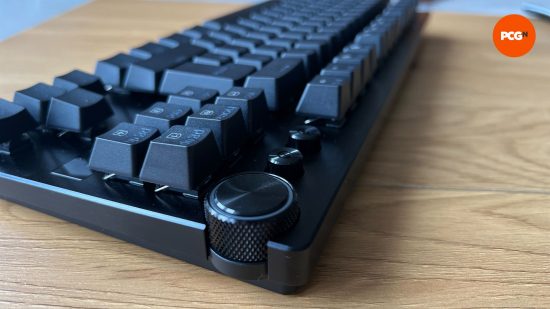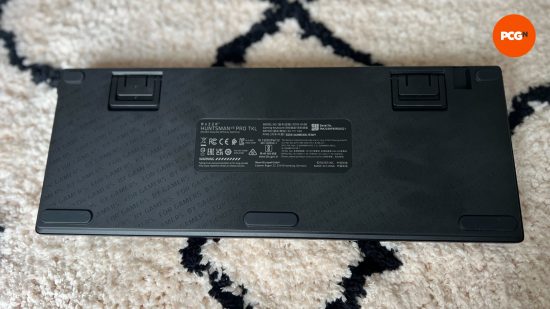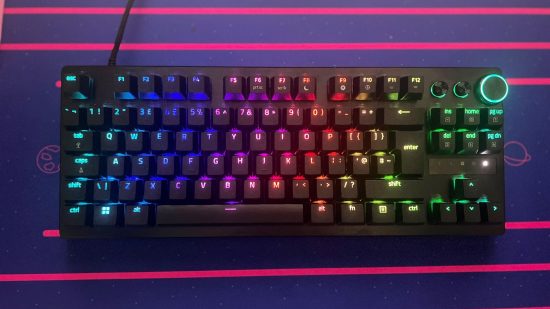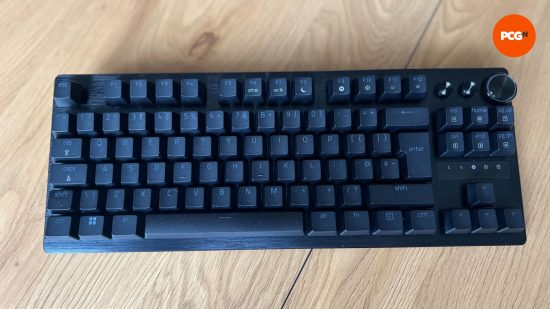Our Verdict
The Razer Huntsman V3 Pro is one of the fastest-responding gaming keyboards available right now, thanks to its optical switches. These also provide useful extra features such as individually adjustable key actuation points and a rapid trigger ability, making for a keyboard that’s at the cutting edge of gaming performance. It also has hard-wearing PBT keycaps that should stand up to thousands of hours of the most aggressive keypresses. However, it lacks physical customization, with no quick release USB cable or hot-swappable switches, plus the feel of its switches isn’t our preference for typing performance. Those are some heavy compromises for its high price.
- Dual bind and rapid trigger
- Brilliant build quality
- Incredibly responsive
- Very loud
- Poor comfort
The Razer Huntsman V3 Pro isn’t built with customization and hot swapping in mind. Instead, it’s aimed at providing raw gaming performance and being the ideal companion for any gamer who takes their K/D ratio perhaps a little too seriously. Building upon a legacy of keyboards striving to be the best esports peripherals, the Huntsman V3 Pro delivers an ultra-fast response time but does very little beyond this to appeal to a wider audience.
Despite not breaking ground across all its features, the Razer Huntsman V3 Pro is still one of the best gaming keyboards you can buy right now. If esports is at the core of your gaming interests, there are few keyboards that can compete for speed of response and customization of the way a keyboard’s keys can be activated.
Why you can trust our advice ✔ At PCGamesN, our experts spend hours testing hardware and reviewing games and VPNs. We share honest, unbiased opinions to help you buy the best. Find out how we test.

Features
The headline feature of the Huntsman V3 Pro is its Razer Gen2 analog optical switches. Optical switches use light to determine when a keypress has been activated, rather than an electrical circuit.
There are several advantages to optical switches as compared to conventional electrical switches. The first is a quicker response, as optical switches don’t require a debounce delay, which is where a conventional switch waits for the physical contacts to stop bouncing off each other before settling on a steady signal.
Optical also allows for analog operation, whereby the switch can not only tell that a switch has been pressed but how far it has been pressed. Not only does this mean you can do things like have a key act like an accelerator or brake pedal, smoothly inputting more or less of a key press, but it also means you can set two actuation points. Press the key a little bit and one action is performed but press firmer and a second action is performed.
An example of this is setting the first actuation point to ready a grenade, while the second stage press throws it. This allows for complete control in the heat of battle, because if you change your mind, there’s no panic to tap in a key combination to cancel your action, you can just lift off the key, and you’re set.
The actuation range for the Huntsman V3 Pro starts rather remarkably at just 0.1mm, extending through to a maximum of 4mm. Customizable actuation points are nothing new, nor unique to optical switches, with magnetic/Hall Effect switches also providing the function. but are still something of a rarity and a premium feature. We’ve seen them in keyboards like the Akko MOD007B, SteelSeries Apex Pro Mini, and Corsair K70 Max.

Design
Razer takes a no-thrills approach with the design of its Huntsman gaming keyboards and the V3 Pro is no different. We tested the TKL model, meaning the number pad typically located on the far right is removed, but the placement and layout of the arrow keys and the six function keys above them remain the same. Above these function keys is a large rotary dial, preset to adjust the audio on your PC but this can be changed in Razer Synapse.
Next to the large dial are two circular buttons, the left being preset to open the Xbox Game Bar while the other is for audio control based on how many times it is pressed. Circling back to the six function keys above the arrows (ins, home, pg up, del, end, and pg dn), on the TKL model these are how you will cycle through your stored profiles. Four of the keys are for the four customized profiles you create in Synapse, one is for the default settings, and the final one is to revert to the most recent settings you used, even if they’re not currently stored in a profile.
The optical analog switches unfortunately create a lot of noise when being used to type, and there is a pitch difference to each line of keys that gets higher the closer you are to the top of the keyboard. I admit to being heavy-handed with keyboards, especially when typing, but the Huntsman V3 Pro is just loud, there’s no sugar-coating it.
There is also a lack of tactile feedback within the keys, creating a very hollow feel to each keystroke. Some people like this, but I would argue in the modern age of keyboards, far more people enjoy a more haptic experience when using a keyboard, and that’s absent here.
Per key RGB is present, which is bordering a standard feature for any keyboard that claims to be targeted at gamers, but still not a guarantee. Given that the Huntsman V3 Pro isn’t wireless, the impact of RGB on performance is inconsequential, but I will note that the lights are very vibrant when at their brightest, though of course the brightness can be adjusted to your taste.
The included wrist rest, however, is an objective disappointment. We’ve gone from the soft padded nature of the Huntsman V2 Pro to a fake leather, flat, and rigid one here with the V3. While no keyboard has to include a wrist rest, if you’re going to do it, then make sure it’s a better product than what Razer has included here, which offers no added benefit or comfort to the user experience.

Performance
Performance is where the Huntsman V3 Pro shines, and it’s hard to fault anything about it, in truth – assuming you don’t mind the light feel of the key switches. If you’re going to drop your hard-earned cash on an expensive keyboard that sells itself on a level of responsiveness that could realistically offer you an advantage in-game, the least it could do is live up to the hype.
Playing around with the actuation points is fun, as you figure out which precise setting is right for you. I often find that core gameplay keys like WASD are better left on lower sensitivity as your hand naturally rests over them, and you’re far less likely to accidentally trigger movement. Mapping out keys that are instead a stretch to reach, or you know firsthand that you struggle with, make for obvious targets when it comes to increased sensitivity.
The Razer analog optical Gen 2 switches have a 40g actuation force, meaning it takes very little force to trigger an activation. Pair this with the potential for 0.1mm actuation and it’s impressive to think how much faster your responses can be when using the Huntsman V3 Pro right.
Where this becomes a bit of a hot debate, is whether the advantage of optical switches (or magnetic switches) is even perceptible to us mere humans, or whether it’s all just smaller or bigger numbers for the sake of it and you’d be better off just going with a switch that you like the feel of more.
One advantage of the Huntsman V3’s analog optical switch (that can’t be matched by a traditional mechanical keyboard) is the ability to assign two bindings to the same key, based on actuation distance.
In practice, this can be tricky to get your head around, as it requires an additional level of thought and you need to be far more careful with your actions so as not to just plow through your first activation step. Setting it up is simple enough, but it’s still a long process that, if you wish to put in place for multiple in-game actions, is an incredible time sink when you could just play the game instead.
Razer opted to not only include dual activation in its Gen 2 switches but Rapid Trigger too, a feature that allows for a key to be reactivated again the moment its momentum moves back towards decompression. It allows for ultra-fast repressing of a key. This can be activated at any time with a function key and it is another advantage to take into any competitive game, I would even say it is more useful than the dual binding based on how much more application there is to Rapid Trigger in virtually every game environment.
The Huntsman V3 Pro isn’t the only keyboard with adjustable actuation or Rapid Trigger. It’s not even the only one to go as low as 0.1mm, because the Wooting 60HE and SteelSeries Apex Pro Mini offer the same.
Verdict
If you’re after a gaming keyboard that takes the gaming aspect very seriously, almost to a fault, the Razer Huntsman V3 Pro is a great choice. I can’t help but feel that as a long-term typing solution, the lack of tactile feedback and the overly loud and hollow sound will become grating.
The TKL model that we reviewed is $219.99 (£219.99), and there are more well-rounded products on the market for less, but if gaming is your calling, and you could genuinely benefit from the rapid response times, dual binding, and excess of profile storage, then the Huntsman V3 Pro is hard to ignore.
Alternatives
Corsair K70 Max
If you want a gaming keyboard that offers a better balance of gaming performance and typing feel, the Corsair K70 Max is a great option with its adjustable actuation MGX switches, but it delivers this balance for a higher cost, which may work against it.
SteelSeries Apex Pro Mini
For something just as driven on gaming performance, but also managing a quieter and more tactile experience, the SteelSeries Apex Pro Mini is a great choice. Again, adjustable actuation and dual bindings are present in the Onmipoint switches. However, for a little bit extra, you can even go wireless should that be a preference.
